Balloons are a part of everyday life for humans and play a routine role in decorations for celebrations. However, dogs may be scared of an inflated balloon as innocent as they may seem.
Just the sight of a balloon could send a dog running from the room, which is inexplicable to humans.
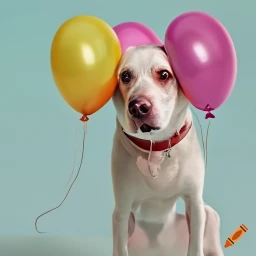 A dog may be scared of a balloon due to the unpredictable movement, smell, or feel of a balloon.
A dog may be scared of a balloon due to the unpredictable movement, smell, or feel of a balloon.
Dogs give several warning signs to show fear, and with gradual practice and desensitization, your dog may be able to overcome its fear.
The sound of balloons rubbing together or popping is quite frightening to dogs. Although many dogs are afraid of balloons, other dogs quite enjoy playing with inflated balloons.
Running after and biting at balloons is fun to exercise your dog and engage its mental capacity. Always use caution when playing with inflated balloons around dogs.
If a balloon is punctured and deflated, it could very easily become a choking hazard or create an internal blockage if the balloon is ingested.
What Is Scary About a Balloon?
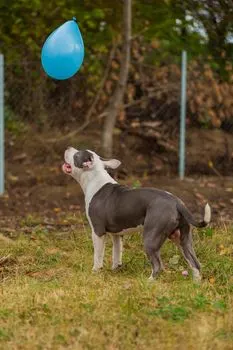 As humans, we interact with balloons regularly, seeing them used as decorations. But for a dog, a balloon can be quite a scary object and create a frightening encounter.
As humans, we interact with balloons regularly, seeing them used as decorations. But for a dog, a balloon can be quite a scary object and create a frightening encounter.
Pet behaviorists aren’t entirely sure why dogs are scared of balloons but have some theories. The leading reasons why dogs are scared of balloons could include:
- Movement – Balloons float and are unpredictable. They are solid objects but are light enough to bounce off furniture and fly through the air. For some dogs, the erratic movement is frightening. Seeing a large object floating above them could mimic the size and shape of a potential predator coming from above for smaller dogs.
- Smell – Balloons are not made of natural materials and have a distinct smell. A dog’s sense of smell is up to 100,000 times better than a human’s, so the smell coming off a rubber balloon is extremely intense. Your dog may find the smell of a rubber balloon overpowering and scary.
- Feel – The smooth texture of a balloon may be foreign and uncomfortable for your dog. If your dog is brave enough to get close to an inflated balloon, it runs the risk of getting a static shock. The combination of touch and sensation may be frightening to some dogs.
Scientists will never know the true reason why a dog is frightened of a balloon. It may be just one of the possible reasons or a combination of many.
If your dog is scared of balloons, never force your dog to interact with them against its will.
Is It OK for Dogs to Play with Balloons?
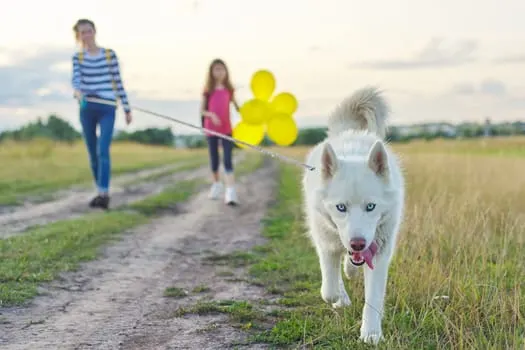 In general, yes, it is safe for dogs to play with an inflated balloon. The real danger occurs if the balloon pops, leaving a deflated, rubber balloon.
In general, yes, it is safe for dogs to play with an inflated balloon. The real danger occurs if the balloon pops, leaving a deflated, rubber balloon.
The balloon could be a potential choking hazard or an obstruction if ingested. Of course, always make sure your dog is comfortable playing with a balloon.
Many dogs are afraid of balloons and should never be forced into playing with something they find frightening.
Although getting a silly reaction out of your dog may be amusing for humans, it is not worth the fear and terror your dog experiences.
Are Balloons Dangerous For Dogs?
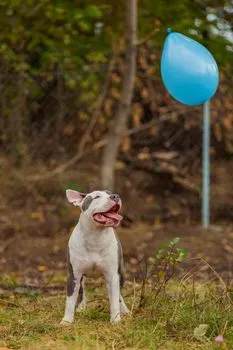 Balloons can pose a possible risk to dogs if left to play unsupervised. An inflated balloon poses no real threat to your dog. A balloon that pops can look like a tasty treat for a dog.
Balloons can pose a possible risk to dogs if left to play unsupervised. An inflated balloon poses no real threat to your dog. A balloon that pops can look like a tasty treat for a dog.
Eating the rubber balloon can create many health problems, including a possible blockage in the stomach or intestine.
This blockage could lead to infection and eventual death if not passed or treated with veterinary medicine. Always supervise your pet when playing with balloons.
What Should I Do If My Dog Ate a Balloon?
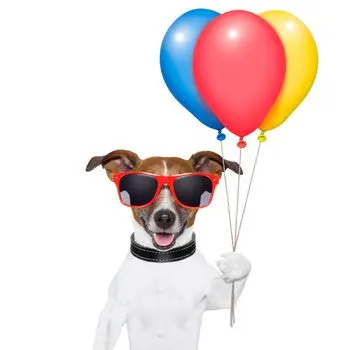 In the unfortunate instance when a dog eats a deflated balloon, quick action can differentiate between life and death. If you notice your dog has ingested a rubber balloon, you should:
In the unfortunate instance when a dog eats a deflated balloon, quick action can differentiate between life and death. If you notice your dog has ingested a rubber balloon, you should:
- Call – Call your veterinarian and report what has happened. Depending on your dog and its medical history, your veterinarian will recommend the next course of action.
- Observe – You’ll want to closely watch your dog to observe any possible allergic reactions or immediate difficulty passing the ingested balloon. Deflated balloons can become a choking hazard for small dogs.
- Pass – Sometimes, your veterinarian will recommend simply watching your dog’s bowel movements. Monitoring your dog’s fecal matter is a great way to confirm the balloon has safely passed through your dog’s system.
- Vomiting – In some cases, your veterinarian may recommend inducing vomiting in your dog to bring the balloon back up. Vomiting may have other side effects associated with it, but it offers a quick way to remove the ingested balloon from your dog’s stomach.
Why Do Some Dogs Love Balloons?
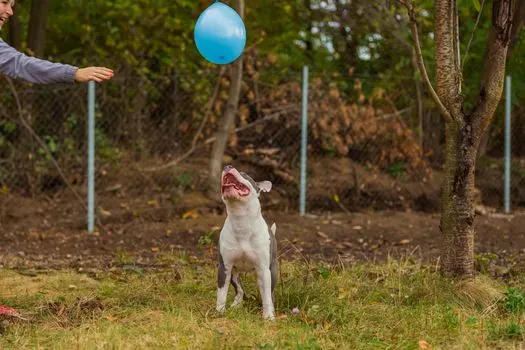 Although several dogs are terrified of balloons, other dogs love to play with the inflatable decoration. Some dogs enjoy the game of jumping and biting at the balloon to help keep the balloon in the air.
Although several dogs are terrified of balloons, other dogs love to play with the inflatable decoration. Some dogs enjoy the game of jumping and biting at the balloon to help keep the balloon in the air.
This game can be a fun playtime activity if you supervise your dog with the balloon.
Whether a dog enjoys balloons or not largely depends on how they associate their time spent with a balloon.
If a dog has a positive interaction with a balloon filled with fun and lively play, the dog is more likely to love balloons.
Alternatively, if the dog experiences a negative interaction, such as a popping balloon that makes a loud and frightening sound, it is more likely to be scared of a balloon.
How Can I Tell If My Dog is Afraid of Balloons?
 Luckily, dogs give some pretty clear body signals when nervous or scared about a situation.
Luckily, dogs give some pretty clear body signals when nervous or scared about a situation.
If you are playing with your dog and a balloon, closely observe your dog’s behavior to determine if it is fearful. Some sure signs of fear in a dog include:
- Ears – When a dog is scared, it’ll change its ear position. Some dogs will pin their ears back to their head, while others will keep their ears pointed and erect.
- Tucked Tail – Seeing a dog with its tail tucked between its legs is a good sign of fear. However, some dogs won’t tuck their tail but will keep their tail down and straight with only a little movement from side to side.
- Licking – A nervous dog will sometimes lick its lips to show that it is nervous or worried about a situation.
- Eyes – Frightened dogs will show more white in their eyes than usual. This motion is sometimes called a whale eye or a half-moon eye.
- Back – When a dog is frightened, it will sometimes hunch its back. The dog will do this in an attempt to disappear or hide from the situation. If your dog hunches its back around balloons, it is a good indicator that your dog is frightened.
How Can I Help My Dog Overcome Its Fear?
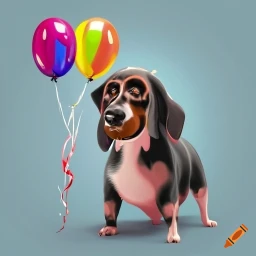 No owner wants to see their dog frightened, especially over something as innocuous as a balloon. Luckily, several methods and tactics help your dog overcome its fear.
No owner wants to see their dog frightened, especially over something as innocuous as a balloon. Luckily, several methods and tactics help your dog overcome its fear.
To help your dog fight its fear of balloons, you can:
- Safety – Give your dog a place in the house where they feel safe, and have the confidence of knowing a balloon won’t be present. This secure place could be another room in the house or a special bed in a quiet area.
- Conditioning – You can try to condition your dog to the balloon to eventually learn to have a positive emotional response to the balloon. Often, associating a positive interaction, like a favorite food or plenty of pets and praises in the presence of a balloon, is enough to change your dog’s opinion. Remember to always work slowly through conditioning and never force your dog to do something it is uncomfortable doing.
- Desensitization – Progress slowly by showing your dog balloons in non-threatening ways. This practice may mean letting your dog smell a deflated balloon or a stationary inflated balloon. The more the dog has a chance to interact with the balloon in a non-threatening way, the more your dog will become desensitized from the encounter. This technique could take weeks or months to accomplish.
Related Questions
Why are dogs scared of thunder?
Thunder is a widespread fear for dogs simply because it comes from an unknown source. A dog doesn’t understand where the sound comes from, so it thinks the sound is a possible threat.
Many dogs will hide when they hear a loud noise like thunder, seeking out a place that makes them feel safe.
Using a white noise machine may help drown out the sound of thunder, helping to calm a scared dog.
Can CBD oil for dogs help calm anxiety?
Anxiety is a real concern for many pet owners, especially when a storm approaches or there are fireworks outside. Specific pet-grade CBD oil is available for dogs to help with anxiety.
Many veterinarians see immediate results with CBD oil and largely condone the use of the oil as a remedy for anxiety. CBD oil can be administered in a treat form or applied to your dog’s food.
Related Guides
Our team is composed of pet care professionals, veterinarians, and pet owners. To date, we’ve conducted thousands of hours of research to publish the most accurate pet information.
Most of the writers on our site are vets with 10+ years of clinical experience, ranging from small practice, to equine practice, academia, and surgery. Our goal is to help every pet owner get the information they seek about their dear companions.

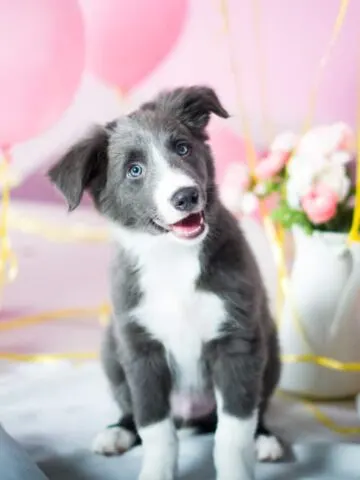

Leave a comment
You must be logged in to post a comment.